Weapons of the Vietnam War

This article is about the weapons used in the Vietnam War, which involved the People's Army of Vietnam (PAVN) or North Vietnamese Army (NVA), National Liberation Front for South Vietnam (NLF) or Viet Cong (VC), and the armed forces of the Army of the Republic of Vietnam (ARVN), United States, Republic of Korea, Philippines, Thailand, and the Australian, New Zealand defence forces, and a variety of irregular troops.
Nearly all United States-allied forces were armed with U.S. weapons including the M1 Garand, M1 carbine, M-14 and M-16. The Australian and New Zealand forces employed the 7.62 mm L1A1 Self-Loading Rifle as their service rifle, with the occasional US M16.
The PAVN, although having inherited a variety of American, French, and Japanese weapons from World War II and the First Indochina War (aka French Indochina War), were largely armed and supplied by the People's Republic of China, the Soviet Union, and its Warsaw Pact allies. In addition, some weapons—notably anti-personnel explosives, the K-50M (a PPSh-41 copy), and "home-made" versions of the RPG-2—were manufactured in North Vietnam. By 1969 the US Army had identified 40 rifle/carbine types, 22 machine gun types, 17 types of mortar, 20 recoilless rifle or rocket launcher types, 9 types of antitank weapons, and 14 anti-aircraft artillery weapons used by ground troops on all sides. Also in use, primarily by anti-communist forces, were the 24 types of armored vehicles and self-propelled artillery, and 26 types of field artillery & rocket launchers.
Communist forces and weapons

Communist forces were principally armed with Chinese and Soviet weaponry though some VC guerrilla units were equipped with Western infantry weapons either captured from French stocks during the first Indochina war, such as the MAT-49, or from ARVN units or requisitioned through illicit purchase.
US weapons
The American M16 rifle, which replaced the M14, was lighter and considered more accurate than the AK-47 but was prone to malfunction. Often the gun suffered from a type II malfunction known as failure to extract or "brass low", which meant that a spent cartridge case remained lodged in the chamber after a bullet flew out the muzzle. According to a congressional report, the malfunction was caused by a change of gunpowder in the ammunition, which was done without adequate testing and by a money saving policy, headed by Pat McNamara, to not issue adequate cleaning kits to soldiers. This led to a myth of a self cleaning gun. These decisions were made without regard to the safety of soldiers and resulted in many deaths.
The heavily armored, 90 mm gun M48A3 'Patton' tank saw extensive action during the Vietnam War and over 600 were deployed with U.S. forces. They played an important role in infantry support though there were few tank versus tank battles. The M67A1 flamethrower tank (nicknamed the Zippo) was an M48 variant used in Vietnam. Artillery was used extensively by both sides but the Americans were able to ferry the lightweight 105 mm M102 howitzer by helicopter to remote locations on quick notice.[1][2] With its 17-mile (27 km) range, the Soviet 130 mm M-46 towed field gun was a highly regarded weapon and used to good effect by the PAVN. It was countered by the long-range, American 175 mm M107 Self-Propelled Gun.[3]
The United States had air superiority though many aircraft were lost to surface-to-air missiles and anti-aircraft artillery. U.S. airpower was credited with breaking the siege of Khe Sanh and blunting the 1972 Easter Offensive against South Vietnam. At sea, the U.S. Navy had the run of the coastline, using aircraft carriers as platforms for offshore strikes and other naval vessels for offshore artillery support. Offshore naval fire played a pivotal role in the Battle of Huế in February 1968, providing accurate fire in support of the U.S. counter-offensive to retake the city.[4]
The Vietnam War was the first conflict that saw wide scale tactical deployment of helicopters.[5] The Bell UH-1 Iroquois nicknamed "Huey" was used extensively in counter-guerilla operations both as a troop carrier and a gunship.[2] In the latter role it was outfitted with a variety of armaments including M60 machine guns, multi-barreled 7.62 mm Miniguns and unguided air-to-surface rockets.[2] The Hueys were also successfully used in MEDEVAC and search and rescue roles.[2]
Weapons of the ARVN, U.S., South Korean, Australian, and New Zealand Forces
Hand combat weapons

- M1917 bayonet - used on various shotguns.
- M1 Bayonet - used on the M1 Garand.
- M4 bayonet - used on the M1 and M2 Carbine.
- M5 bayonet - used on the M1 Garand.
- M6 bayonet - used on the M14.
- M7 Bayonet - used on the M16.
- Ka-Bar Utility/fighting Knife - used by the US Navy and Marine Corps.
- Gerber Mark II U.S. Armed Forces
Pistols and revolvers
- Colt M1911A1 – standard US and ARVN sidearm.
- Colt Model 1903 Pocket Hammerless – carried by US military officers. Replaced by the Colt Commander in the mid-1960s
- Colt Commander – replaced the Colt M1903 as an officer's sidearm in the mid-1960s.
- Browning Hi-Power – used by Australian and New Zealand forces. Also used on an unofficial basis by US reconnaissance and Special Forces units.
- Ingram MAC-10 – automatic pistol used by US special operations forces.[6]
- M1917 revolver – .45 ACP revolver used by the South Vietnamese and US forces during the beginning of the war alongside the Smith & Wesson Model 10. Used rather prominently by Tunnel Rats units.
- Smith & Wesson Model 10 – .38 Special revolver used concurrently with Colt and S&W M1917 revolvers.
- Smith & Wesson Model 12 – .38 Special revolver carried by US Army and USAF pilots.
- Smith & Wesson Model 15 – .38 Special revolver carried by USAF Security Police Units.
- Smith & Wesson Model 27 – .357 Magnum revolver carried by MACVSOG.
- Smith & Wesson Mark 22 Mod.0 "Hush Puppy" – Suppressed pistol used by US Navy SEALs and other U.S. special operations forces.[6]
- High Standard HDM – Integrally suppressed .22LR handgun, supplemented by the Mark 22 Mod 0 in the later stages of the war.[6]
Infantry rifles

- L1A1 Self-Loading Rifle – used by Australian and New Zealand soldiers in Vietnam
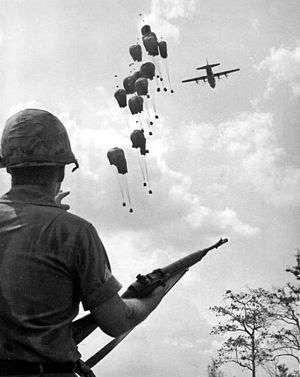
- M1 Garand – used by the South Vietnamese, South Koreans and Laotians. Limited numbers were carried by early U.S. advisors and USMC troops.
- M1, M1A1, & M2 Carbine – used by the South Vietnamese Military, Police and Security Forces, U.S. military, and Laotians supplied by the U.S.
- M14 rifle - issued to most U.S. troops from the early stages of the war until 1967-68, when it was replaced by the M16.[7]
- M16, XM16E1, and M16A1 – M16 was issued in 1963, but due to reliability issues, it was replaced by the M16A1 in 1967 which added the forward assist and chrome-lined barrel to the rifle for increased reliability.[8]
- CAR-15 – carbine variant of the M16 produced in very limited numbers, fielded by special operations early on. Later supplemented by the improved XM177.
- XM177 (Colt Commando)/GAU-5 – further development of the CAR-15, used heavily by MACV-SOG, the US Air Force, and US Army.[6]
- Stoner 63 – used by US Navy SEALs and USMC.[6]
- Heckler & Koch G3 – used by Thai forces
- Heckler & Koch HK33 – used by Thai forces that were not armed by the United States. It was chambered for the same cartridge as the M16
- T223 – a copy of the Heckler & Koch HK33 built under license by Harrington & Richardson used in small numbers by SEAL teams. Even though the empty H&R T223 was 0.9 pounds (0.41 kg) heavier than an empty M16A1, the weapon had a forty-round magazine available for it and this made it attractive to the SEALS.[6]
- M1917 Enfield
- Type 56 Captured rifles were used by South Vietnamese and U.S forces.
Sniper/marksman rifles
- M1C/D Garand – Approximately 520 were supplied to the ARVN by the United States.
- M1903A4 Springfield – used by the USMC early in the war, replaced by the M40.
- Winchester Model 70 – used by the USMC and on a much more limited basis by the US Army.
- M21 Sniper Weapon System – sniper variant of the M14 rifle used by the US Army.
- M40 – bolt-action sniper rifle meant to replace the M1903A4 Springfield rifle and Winchester Model 70; used by the USMC and ARVN.
Submachine guns
- Thompson submachine gun – used often by South Vietnamese troops, and in small quantities by US artillery and helicopter units.
- M3 Grease gun – standard U.S. military submachinegun, also used by the South Vietnamese[6]
- Carl Gustav M/45 – used by Navy SEALs in the beginning of the war, but later replaced by the Smith & Wesson M76 in the late 1960s. Significant numbers were also utilized by the South Vietnamese,[6] and limited numbers were used in Laos by advisors, and Laotian fighters.
- Smith & Wesson M76 – copy of the Carl Gustav M/45, replacing it in 1967.[6]
- Madsen M-50 – used by South Vietnamese forces, supplied from Denmark.[6]
- Owen Gun – standard Australian submachine-gun in the early stages of the war, later replaced by the F1.
- F1 submachine gun – replaced the Owen Gun in Australian service.
- Sterling submachine gun – used by Australian Special Air Service Regiment and other special operations units.
- Sten submachine gun – used by US special operations forces, often with a suppressor mounted.
- Uzi – used by special operations forces, supplied from Israel.
- Beretta M12 – limited numbers were used by U.S. Embassy security units.[9]
- MAT-49 submachine gun – captured models were used in limited numbers[6]
- M50/55 Reising – limited numbers were used by MACVSOG and other irregular forces.[6]
Shotguns
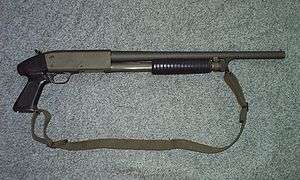
Shotguns were used as an individual weapon during jungle patrol; infantry units were authorized a shotgun by TO&E (Table of Organization & Equipment). Shotguns were not general issue to all infantrymen, but were select issue weapons, such as one per squad, etc.
- Browning Auto-5 - semi-automatic shotgun used by ARVN forces
- Ithaca 37 – pump-action shotgun used by the United States and ARVN.[6]
- Remington Model 870 – pump-action shotgun primary shotgun used by Marines after 1966.[6]
- Remington 7188 – experimental select fire shotgun, withdrawn due to lack of reliability.Used by US Navy SEALs[6]
- Special Operations Weapon - A modification for a Remington 1100 which made it fully automatic.
- Winchester Model 21 - used by ARVN forces.
- Winchester Model 1200 – pump-action shotgun used by the US Army.
- Winchester Model 1897 – used by the Marines during the early stages of the war, but later replaced by the Remington Model 870.
- Stevens Model 77E – pump-action shotgun used by Army and Marine forces. Almost 70,000 Model 77Es were procured by the military for use in SE Asia during the 1960s. Also very popular with the ARVN because of its small size.
- [[Stevens Model 520/620|
Machine guns
- M60 machine gun – standard General-purpose machine gun for US, ANZAC, and ARVN forces throughout the war.[6]
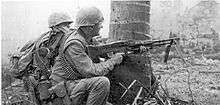
- Colt Machine Gun – experimental light machine gun deployed by SEAL Team 2 in 1970.[6]
- M1918A2 – used by the ARVN during the early stages of the war, as well as many that were airdropped into Laos and used by Laotian fighters.
- Stoner M63A Commando & Mark 23 Mod.0 – used by Navy SEALs and tested by Force Recon.[6]
- Heckler & Koch HK21 – used by Thai forces.
- M1917 Browning machine gun – .30cal heavy machine gun issued to the ARVN and also in limited use by the U.S. Army.
- M1919 Browning machine gun – vehicle and helicopter mounted machine gun. Also fitted to Australian M113 Light Reconnaissance Vehicles.[6] Meanwhile, still of use by many South Vietnamese and Laotion infantry forces.
- Browning M2HB .50cal Heavy Machine Gun[6]
- Stoner 63
Grenades and mines

- Mark 2 fragmentation grenade
- M26 fragmentation grenade and many subvariants
- M67 fragmentation grenade
- Mills Bomb - Used by ANZAC forces.
- M6/M7-series riot control grenades - Used to clear NVA/VC out of caves, tunnels and buildings.[10]
- AN/M14 TH3 thermate grenade - Incendiary grenade used to destroy equipment and as a fire-starting device.
- M15 and M34 smoke grenades - filled with white phosphorus, which ignites on contact with air and creates thick white smoke. Used for signalling and screening purposes, as well as an anti-personnel weapon in enclosed spaces, as the burning white phosphorus would rapidly consume any oxygen, suffocating the victims.
- M18 grenade Smoke Hand Grenade - Signaling/screening grenade available in red, yellow, green, and purple.
- XM58 riot control grenade - A miniature riot control grenade used by MACVSOG and Navy SEALs.[11]
- M14 mine - anti-personnel blast mine
- M16 mine - bounding anti-personnel fragmentation mine
- M18/M18A1 Claymore - command-detonated directional anti-personnel mine
Grenade and Rocket Launchers
- M1/M2 rifle grenade adapters - used to convert a standard fragmentation grenade (M1) or smoke grenade (M2) into a rifle grenade in conjunction with the M7 grenade launcher.
- M7 grenade launcher - rifle grenade launcher used with the M1 Garand, used by the South Vietnamese soldiers. Could fire the M9A1 HEAT, M22 smoke, and M31 HEAT rifle grenades.
- M31 HEAT rifle grenade – Used primarily by the U.S. Army before the introduction of the M72 LAW. Fired from the M1 Garand and M14 Rifle.
- M79 Grenade Launcher - primary U.S. grenade launcher used by all branches of the US military, as well as ANZAC forces and the ARVN.[6]
- China Lake Grenade Launcher - pump action weapon used in very small numbers.[6]
- XM148 - experimental underbarrel 40mm grenade launcher that could be attached to the M16 rifle or XM177 carbine. Withdrawn due to safety reasons.[6]
- M203 grenade launcher - single-shot 40mm underslung grenade launcher designed to attach to a M16 rifle (or XM177 carbine, with modifications to the launcher). First tested in combat April 1969.[6]
- Mark 18 Mod 0 grenade launcher - Hand-cranked, belt-fed, 40x46mm grenade launcher used by the US Navy.[12]
- Mark 19 grenade launcher - Automatic, belt-fed, 46x53mm grenade launcher.[13]
- Mk 20 Mod 0 grenade launcher - Automatic, belt-fed, 40x46mm grenade launcher. Primarily used by riverine crews but also used by Air Force Special Operations.[13]
- XM174 grenade launcher - Automatic, belt-fed, 40x46mm grenade launcher used mainly by the US Air Force.
- Bazooka - The M1A1, M9, and M9A1 variants were used by the ARVN until the late 1960s, while the M20 "Super Bazooka" was used by the USMC until the introduction of the M72 LAW.
- M72 LAW – 66mm anti-tank rocket launcher.
- XM191 - experimental four-shot 66mm incendiary rocket launcher.
- FIM-43 Redeye MANPADS (Man-Portable Air-Defence System) – shoulder-fired heat-seeking anti-air missile, used by the US Army and USMC.
Flamethrowers
Infantry support weapons
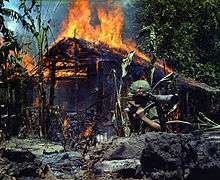
- M18 recoilless rifle - 57mm shoulder-fired/tripod mounted recoilless rifle, used by the ARVN early in the war.
- M20 recoilless rifle - 75mm tripod/vehicle-mounted recoilless rifle, used by US and ARVN forces early in the war.
- M67 recoilless rifle - 90mm shoulder-fired anti-tank recoilless rifle, used by the US Army and Marine Corps.
- M40 recoilless rifle 106mm tripod/vehicle-mounted recoilless rifle.
- M2 mortar - 60mm mortar, used in conjunction with the lighter but less accurate and lower-range M19 mortar.
- M19 mortar - 60mm mortar, used in conjunction with the older, heavier M2 mortar.
- M29 mortar - 81mm mortar, used by US and ARVn forces.
- M30 mortar 107mm mortar (Often referred to as the "four deuce", in reference to its 4.2-inch diameter.)
Optics
- Colt Scope - Colt-manufactured 3x-magnification scope mounted on the carrying handle of the M16 and CAR-15 family.
- Adjustable Ranging Telescope - a 3-9x adjustable magnification scope that served as the primary optic of the XM21 sniper rifle. Also mounted on the Model 655 and 656 sniper variants of the M16.
- M82/M84 - 2.2x-magnification scope used on the M1C and M1D Garand sniper rifles.
- Weaver Model 330/330C - 2.75x-magnification scope used on the M1903A4 sniper rifle. Also designated as the M73/M73B1 scopes.
- Redfield Accurange - Redfield-manufactured 3-9x adjustable magnification scope that served as the primary optic of the M40 sniper rifle.
- Unertl 10x - Unertl-manufactured 10x-magnification scope that served as the primary optic of the M40A1 sniper rifle.
- Unertl 8x43 - Unertl-manufactured 8x-magnification scope that served as the primary optic of the Winchester Model 70 sniper rifle.
- Single Point - a primitive occluded eye gunsight meant to be mounted on the M16 and CAR-15 family. The predecessor of the modern red dot sight.
- AN/PAS-4 - Infrared scope mounted on the M14 rifle.
- AN/PVS-1 Starlight Scope - night-vision scope used for night operations; replaced the AN/PAS-4. Typically mounted on the M14 rifle.
- AN/PVS-2 Starlight Scope - successor to the AN/PVS-1. Typically mounted on the M16 rifle, but could also be mounted on the XM21 sniper rifle.
- AN/PVS-3A Starlight Scope - successor to the AN/PVS-2. Like the AN/PVS-2, it could be mounted on the M16 and XM21.
Artillery

- 105 mm Howitzer M2A1
- 105 mm Howitzer M102
- 155 mm Howitzer M114
- M53 Self-propelled 155mm gun
- M55 Self-propelled 8-inch howitzer
- M107 Self-propelled 175mm gun
- M108 Self-propelled 105 mm howitzer
- M109 Self-propelled 155 mm howitzer
- M110 Self-propelled 8-inch howitzer
- 75mm Pack Howitzer M1
- L5 pack howitzer 105 mm pack howitzer used by Australia
- MIM-23 Hawk - medium-range surface to air missile used in very small quantities by the US Marines.[14]
Artillery ammunition types
- Beehive flechette rounds - Antipersonnel rounds.
- Canister - Antipersonnel rounds.
- White phosphorus - Used for screening purposes.
- HE (High Explosive).
Aircraft
(listed alphabetically by modified/basic mission code, then numerically in ascending order by design number/series letter)
- A-1 Skyraider - ground attack aircraft
- A-3 Skywarrior - carrier-based bomber
- A-4 Skyhawk - carrier-based strike aircraft
- A-6 Intruder - carrier-based all weather strike aircraft
- A-7 Corsair II - carrier-based strike aircraft
- A-26 Invader - light bomber
- A-37 Dragonfly - ground attack aircraft
- AC-47 Spooky - gunship
- AC-119G "Shadow" - gunship
- AC-119K "Stinger" - gunship
- AC-130 "Spectre" - gunship
- AU-23 Peacemaker - ground attack aircraft
- AU-24 Stallion - ground attack aircraft
- B-26 Marauder - medium bomber
- B-52 Stratofortress - heavy bomber
- B-57 Canberra - medium bomber
- B-66 Destroyer - medium bomber
- Canberra B.20 - Royal Australian Air Force medium bomber
- C-1 Trader - cargo/transport aircraft
- C-2 Greyhound - cargo/transport aircraft
- C-5 Galaxy - strategic lift cargo aircraft
- C-7 Caribou - tactical cargo aircraft, used by the U.S. Air Force and the Royal Australian Air Force
- C-46 - cargo/transport aircraft
- C-47 - cargo/transport aircraft
- C-97 Stratofreighter - cargo/transport aircraft
- C-119 Boxcar - cargo/transport aircraft
- C-123 Provider - cargo/transport aircraft
- C-124 Globemaster II - cargo/transport aircraft
- C-130 Hercules - cargo/transport plane
- C-133 Cargomaster - cargo/transport aircraft
- C-141 Starlifter - strategic cargo aircraft
- CA-27 Sabre - fighter jet used by the Royal Australian Air Force
- E-1 Tracer - carrier-based airborne early warning (AEW) aircraft
- E-2 Hawkeye - carrier-based airborne early warning (AEW) aircraft
- EA-3 Skywarrior - carrier-based tactical electronic reconnaissance aircraft
- EA-6B Prowler - carrier-based electronic warfare & attack aircraft
- EB-57 Canberra - tactical electronic reconnaissance aircraft
- EB-66 - tactical electronic reconnaissance aircraft
- EC-121 - reconnaissance aircraft
- EF-10 Skyknight - tactical electronic warfare aircraft
- EKA-3B Skywarrior - carrier-based tactical electronic warfare aircraft
- F-4 Phantom II - carrier and land based fighter-bomber
- F-5 Freedom Fighter - light-weight fighter used in strike aircraft role
- F-8 Crusader - carrier and land based fighter-bomber
- F-14 Tomcat - carrier-based fighter, made its combat debut during Operation Frequent Wind, the evacuation of Saigon, in April 1975
- F-100 Super Sabre - fighter-bomber
- F-102 Delta Dagger - fighter
- F-104 Starfighter - fighter
- F-105 Thunderchief - fighter-bomber
- F-111 Aardvark - medium bomber
- HU-16 Albatross - rescue amphibian
- KA-3 Skywarrior - carrier-based tactical aerial refueler aircraft
- KA-6 Intruder - carrier-based tactical aerial refueler aircraft
- KB-50 Superfortress - aerial refueling aircraft
- KC-130F Hercules - tactical aerial refueler/assault transport aircraft
- KC-135 Stratotanker - aerial refueling aircraft
- O-1 Bird Dog - light observation airplane
- O-2 Skymaster - observation aircraft
- OV-1 Mohawk - battlefield surveillance and light strike aircraft
- OV-10 Bronco - light attack/observation aircraft
- P-2 Neptune - maritime patrol aircraft
- P-3 Orion - maritime patrol aircraft
- QU-22 Pave Eagle (Beech Bonanza) - electronic monitoring signal relay aircraft
- RA-3B Skywarrior - carrier-based tactical photographic reconnaissance aircraft
- RA-5C Vigilante - carrier-based tactical photographic reconnaissance aircraft
- RB-47 Stratojet - tactical photographic reconnaissance aircraft
- RB-57 Canberra - tactical photographic reconnaissance aircraft
- RB-66 - tactical photographic reconnaissance aircraft
- RF-4 Phantom II - carrier and land-based tactical photographic reconnaissance aircraft
- RF-8 Crusader - carrier-based tactical photographic reconnaissance aircraft
- RF-101 Voodoo - tactical photographic reconnaissance aircraft
- S-2 Tracker - carrier-based anti-submarine warfare (ASW) aircraft
- SR-71 Blackbird - strategic reconnaissance aircraft
- TA-4F Skyhawk - fast forward air controller
- TF-9J Cougar - fast forward air controller
- T-28 Trojan - trainer/ground attack aircraft
- U-2 - reconnaissance aircraft
- U-6 Beaver - utility aircraft
- U-10 Helio Courier - utility aircraft
- U-17 Skywagon - utility aircraft
- YO-3 Quiet Star - light observation airplane
_at_anchor_in_the_Mekong_Delta_ca_late_1960s.jpg)
Helicopters
(listed numerically in ascending order by design number/series letter, then alphabetically by mission code)
- UH-1A/B/C/D/E/F/H/L/M/P Iroquois "Huey" - utility transport and gunship helicopter
- AH-1G HueyCobra - attack helicopter
- AH-1J SeaCobra - twin-engine attack helicopter
- HH-1K Iroquois - search and rescue (SAR) helicopter
- UH-1N Iroquois - twin-engine utility helicopter
- SH-2 Seasprite - carrier-based anti-submarine warfare (ASW) helicopter
- UH-2 Seasprite - carrier-based utility helicopter
- CH-3 Sea King - long-range transport helicopter
- HH-3 "Jolly Green Giant" - long-range combat search and rescue (CSAR) helicopter
- SH-3 Sea King - carrier-based anti-submarine warfare (ASW) helicopter
- UH-3 Sea King - carrier-based utility helicopter
- OH-6A Cayuse "Loach" (from LOH - Light Observation Helicopter) - light transport/observation (i.e., scout) helicopter
- OH-13 Sioux - light observation helicopter
- UH-19 Chickasaw - utility transport helicopter
- CH-21 Shawnee - cargo/transport helicopter
- OH-23 Raven - light utility helicopter
- CH-34 Choctaw - cargo/transport helicopter
- CH-37 Mojave - cargo/transport helicopter
- HH-43 Huskie -firefighting/rescue helicopter
- CH-46 Sea Knight - cargo/transport helicopter
- CH-47 Chinook - cargo/transport helicopter
- CH-53 Sea Stallion - heavy-lift transport helicopter
- HH-53 "Super Jolly Green Giant" - long-range combat search and rescue (CSAR) helicopter
- CH-54 Tarhe "Sky Crane" - heavy lift helicopter
- OH-58A Kiowa - light transport/observation helicopter
Aircraft ordnance
- GBUs
- CBUs
- BLU-82 Daisy cutter
- Napalm
- Bomb, 250 lb, 500 lb, 750 lb, 1000 lb, HE (high explosive), general-purpose
- Rocket, aerial, HE (High Explosive), 2.75 inch
Aircraft weapons
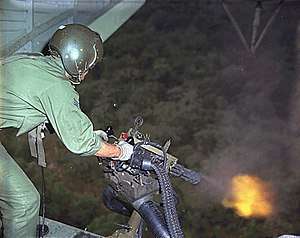
- M61 Vulcan - 20 mm (aircraft mount)
- M39 cannon - 20 mm (aircraft mount)
- AN/M3 cannon - 20 mm (aircraft mount)
- Minigun - 7.62 mm (aircraft and helicopter mount)
- M197 Gatling gun - 20 mm
- M60 machine gun - 7.62mm (helicopter mount)
- AIM-4 Falcon
- AIM-7 Sparrow
- AIM-9 Sidewinder
- AGM-12 Bullpup
- AGM-62 Walleye
- AGM-45 Shrike
- AGM-78 Standard ARM
Chemical weapons
- Agent Orange – While not developed to be used as a weapon against infantry, it was later revealed that it had the potential to cause cancer and other diseases in those who came in contact with it.
- Napalm
- CS Riot Gas - Used in grenades, cluster bomblets, and used by MACVSOG in powder form.
Vehicles
In addition to cargo-carrying and troop transport roles, many of these vehicles were also equipped with weapons and sometimes armor, serving as "gun trucks" for convoy escort duties.
- M274 Truck, Platform, Utility, 1/2 Ton, 4X4 - Commonly called a "Mechanical Mule"
- Land Rover (short and long wheelbase) – Australian and New Zealand forces.
- Willys M38A1 - 1/4 ton jeep.
- M151 - 1/4 ton jeep.
- M76 Otter - amphibious cargo carrier used by USMC.
- Dodge M37 - 3/4 ton truck.
- Kaiser Jeep M715 - 1¼ ton truck.
- M35 series 2½-ton 6x6 cargo truck
- M135 2 1/2-ton truck
- M54 5-ton 6x6 truck
- M520 Goer - 4x4 8-ton cargo truck.
Combat vehicles
Tanks
- M24 Chaffee – light tank; main ARVN tank early in the war, used at least as late as the Tet Offensive.
- M41 Walker Bulldog – light tank, replaced the M24 Chaffee as the main ARVN tank in 1964-1965.
- M48 Patton medium tank – main tank of the US Army and Marines throughout the war, and also used by ARVN forces late-war.
- M67 "Zippo" – flamethrower variant of the M48 Patton.
- M551 Sheridan – Armored Reconnaissance Airborne Assault Vehicle/Light Tank, used by the US Army from 1969.
- Centurion MK.V Main Battle Tank – used by the Australian Army.
Other armored vehicles
- M113 - APC (Armored Personnel Carrier)
- M113 ACAV - Armored Cavalry Assault Vehicle
- M163 Vulcan - self-propelled anti-aircraft tank
- M114 - reconnaissance vehicle
- M2 Half Track Car
- M3 Scout Car - used by South Vietnamese forces early in the war.
- M3 Half-track - used by South Vietnamese forces early in the war.
- M5 Half-track
- M9 Half-track
- M59 (APC)
- M75 (APC)
- LVTP5 (aka AMTRACs) - amphibious tractors/landing craft used by USMC
- Cadillac Gage V-100 Commando
- M8 Greyhound Used by ARVN forces early in the war.
- M56 Scorpion
- M50 Ontos - self-propelled 106 mm recoilless rifle carrier used by the USMC until 1969. Some were later transferred to ARVN forces.
- M42 Duster - M41 based hull, with a twin 40 mm antiaircraft gun mounted on an open turret
- M728 Combat Engineer Vehicle - modified M60 Patton tank equipped with dozer blade, short-barreled 165mm M135 Demolition Gun, and A-Frame crane.
- M60 AVLB - armored vehicle launched bridge using M60 Patton chassis.
- M88 Recovery Vehicle - armored recovery vehicle based on M48 and M60 chassis.
Naval craft
_slow.jpg)
- Tango, LCM - Monitor, heavily gunned riverine craft
- Swift Boat - Patrol Craft Fast (PCF)
- ASPB - assault support patrol boat, (known as Alpha boats)
- PBR - Patrol Boat River, all-fiberglass boats propelled by twin water jets, used by the US Navy
- LARC-LX
- BARC
- LCVP - Landing craft vehicle personal
- LCM - Landing craft mechanised
Communications
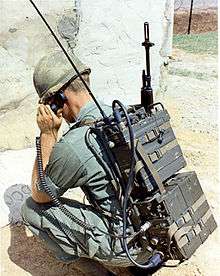
Radios
The geographically dispersed nature of the war challenged existing military communications. From 1965 to the final redeployment of tactical units, numerous communications-electronics systems were introduced in Vietnam to upgrade the quality and quantity of tactical communications and replace obsolete gear:[15]
- AN/PRT-4 and PRR-9 squad radios - replaced the AN/PRC-6.
- AN/PRC-25 and 77 - short-range FM radios replaced the AN/PRC-8-10.
- AN/VRC-12 series - FM radios replaced the RT-66-67-68/GRC (including AN/GRC 3-8, VRC 7-10, VRC 20-22, and VRQ 1-3 sets).
- AN/GRC-106 - AM radios and teletypewriter replaced the AN/GRC-19.
Encryption systems
Encryption systems developed by the National Security Agency and used in Vietnam included:[16]
- NESTOR - tactical secure voice system, including the TSEC/KY-8, 28 and 38 was used with the PRC-77 and VRC-12
- KW-26 - protected higher level teletype traffic
- KW-37 - protected the U.S. Navy fleet broadcast
- KL-7 - provided offline security
- A number of paper encryption and authentication products, including one time pads and the KAL-55B Tactical Authentication System
Weapons of the PAVN/NLF/North Korea/Soviet Union/China
The NVA (North Vietnamese Army) and the Southern communist guerrillas, the NLF, or Viet Cong as they were commonly referred to during the war, largely used standard Warsaw Pact weapons. Weapons used by the North Vietnamese also included Chinese Communist variants, which were referred to as CHICOM's by the US military. Captured weapons were also widely used; almost every small arm used by SEATO may have seen limited enemy use. During the early 1950s, US equipment captured in Korea was also sent to the Viet Minh.
Small arms

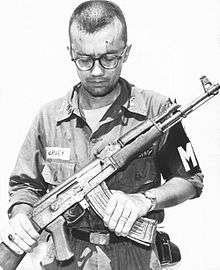

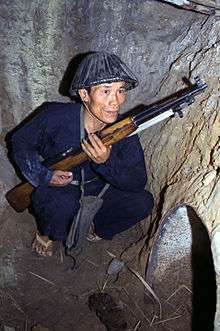
Hand combat weapons

- A wide variety of bayonets meant for fitting on the many types of rifles used by the NVA and VC.
- Gunto – Sword, captured from the Japanese during World War II
- Other types of knives, bayonets, and blades
Handguns and revolvers
- Luger P08 – Captured by the Soviets during World War II and provided to the VPA and the NLF as military aid
- Makarov PM[17]
- Mauser C96 – Locally produced copies were used alongside Chinese copies and German variants supplied by the Soviets
- M1892 – Captured from the French in the Indochina War.
- M1935 – Captured from the French in the Indochina War.
- Nagant M1895 revolver
- P-64 CZAK handgun
- Škorpion vz. 61 automatic pistol[18]
- Stechkin automatic pistol
- Tokarev TT-33[17]
- Type 14 8 mm Nambu Pistol – Captured from the Japanese during World War II
- Walther P38 – Captured by the Soviets during World War II and provided to the VPA and the NLF as military aid
Automatic and semi-automatic rifles
- AK-47– from the Soviet Union and Warsaw Pact countries
- AKM – from the Soviet Union and Warsaw Pact countries
- MAS-49 rifle – captured French rifle from first Indochina War
- SKS semi-automatic carbine
- SVD-63 semi-automatic marksman rifle
- Sturmgewehr 44 assault rifle, captured by the Soviets during World War II and provided to the VPA and the NLF as military aid
- SVT-40 semi-automatic rifle
- Type 56 assault rifle – from the People's Republic of China
- Type 58 assault rifle – from North Korea
- Type 63 assault rifle
- Vz. 58 assault rifle – from Czechoslovakia
- M1 Carbine - captured semi-automatic rifle used by the United States
- M2 Carbine - captured from South Vietnamese forces
Bolt-action rifles
- Mauser Kar98k – Bolt-action rifle (captured from the French during the First Indochina War and also provided by the Soviets as military aid).
- MAS-36 rifle – Captured French rifle from first Indochina War, used by NVA in earlier stages of the Vietnam War.
- M91/30 rifle – Bolt-action rifles and carbines from the Soviet Union, Warsaw Pact countries, and the People's Republic of China.
- vz. 24 – Used by Viet Cong Forces.
Submachine guns
- K-50M submachine gun (Vietnamese edition, based on Chinese version of Russian PPSh-41, under licence)
- MAS-38 submachine gun – Captured from the French in the Indochina War.
- MAT-49 submachine gun – Captured during the French-Indochina War. Many were converted from 9x19mm to 7.62x25 Tokarev[6]
- MP 38/MP 40 – (captured by the Soviets during World War II)
- PM-63 submachine gun
- PPS-43 submachine gun
- PPSh-41 submachine gun (both Soviet and Chinese versions)
Machine guns
- Degtyarev DP Replaced by the RPD in 1968
- DShK heavy machine gun
- FM-24/29 captured from the French in the Indochina War
- MG 08 - used by the Viet Cong Forces
- MG-34 light machine gun captured by the Soviets during World War II and provided to the VPA and the NLF as military aid
- MG-42 medium machine gun captured by the Soviets during World War II and provided to the VPA and the NLF as military aid
- PM M1910 Scrapped in 1972
- RPD light machine gun
- SG-43/SGM medium machine guns including Communist Chinese copies of these guns
- Uk vz. 59 general-purpose machine gun
- ZB vz. 26 light machine gun
- ZB vz.30 - light machine gun from Czechoslovakia
- ZB-50 - heavy machine gun from Czechoslovakia
- ZB-53 - Medium machine gun from Czechoslovakia
- ZB vz.60 - heavy machine gun from Czechoslovakia
Grenades and mines
- Molotov cocktail
- F1 grenade
- Model 1914 grenade
- RG-41
- RG-42 grenade
- RGD-5 grenade
- RGD-33 stick Grenade
- RPG-40 Anti-Tank Hand Grenade
- RPG-43 HEAT (High Explosive Anti-Tank) Hand Grenade
- RPG-6
- Type 4 grenade
- Type 10 grenade
- Type 67 stick grenade
- Type 91 grenade
- Type 97 grenade
- Type 99 grenade
- Type 10 grenade discharger
- Type 89 grenade discharger
Rocket launchers, recoilless rifles, and anti-tank rifles
- RPG-2 recoilless rocket launcher (both Soviet and locally produced B-40 and B-50 variants used)
- RPG-7 recoilless rocket launcher
- Type 69 RPG anti-tank weapon
- 9K32 Strela-2 anti-aircraft weapon
- B-10 recoilless rifle
- B-11 recoilless rifle
- SPG-9 73 mm recoilless rifle
- Type 56 recoilless rifle
- PTRD Used by the Viet Cong Forces.
Flamethrowers
- LPO-50 Flamethrower (limited use)
- ROKS flamethrowers (limited use)
- Type 93/Type 100 flamethrower (limited use)
Artillery


- Type 97 81mm mortar
- 82-PM-41 - 82mm mortar.
- Type 94 90mm mortar
- Type 97 90 mm mortar
- M1938 107mm mortar
- M1938 120mm mortar
- Type 97 150 mm mortar
- M1943 160mm mortar
- Type 4 20 cm Rocket Launcher
- Type 4 40 cm Rocket Launcher
- Type 63 multiple rocket launcher
- 76 mm divisional gun M1942 (ZiS-3)
- 85 mm divisional gun D-44
- 8 cm/40 3rd Year Type naval gun
- 100 mm field gun M1944 (BS-3)
- Type 91 10 cm howitzer
- 122 mm gun M1931/37 (A-19)
- 122 mm howitzer M1938 (M-30)
- D-74 122 mm Field Gun
- Type 38 12 cm howitzer
- Type 96 15 cm howitzer
- Type 4 15 cm Howitzer
- 130 mm towed field gun M1954 (M-46)
- 152 mm howitzer M1943 (D-1)
- 152 mm towed gun-howitzer M1955 (D-20)
- BM-8/BM-13/BM-31 MRL
- BM-21 Grad MRL
- BM-14 MRL
- BM-24 MRL
Anti-aircraft weapons
- ZPU-1/2/4 single, double and quad 14.5 mm anti-aircraft machine guns
- ZU-23 twin 23 mm anti-aircraft cannon
- Type 96 25mm Gun
- M1939 37 mm anti-aircraft gun
- S-60 57 mm anti-aircraft gun
- 85 mm air defense gun M1939 (52-K)
- 100 mm air defense gun KS-19
- S-75 Dvina Soviet high-altitude air defence system
Aircraft
- An-2 utility aircraft
- Ilyushin Il-14 transport aircraft
- Lisunov Li-2 transport aircraft
- MiG-17 jet fighter
- MiG-19 jet fighter, used in limited numbers
- MiG-21 jet fighter
- Shenyang J-5 jet fighter
- Shenyang J-6 jet fighter
Aircraft weapons
Helicopters
Support vehicles
Tanks
- PT-76 amphibious tank
- SU-100 self-propelled guns in limited numbers.
- T-34-85 medium tank, used in limited numbers
- T-54/55 main battle tanks
- Type 59 main battle tanks
- Type 62 light tank
- Type 63 anti-aircraft self-propelled systems
- Type 63 amphibious tank
- Type 95 Ha-Go light tank, used in limited numbers
- Type 97 Chi-Ha medium tank, used in limited numbers
- ZSU-57-2 anti-aircraft self-propelled systems
- ZSU-23-4 anti-aircraft self-propelled systems
Other armored vehicles
Naval craft
- P 4-class torpedo boat - used by Vietnam People's Navy
- Countless civilian-type sampans - mainly used for smuggling supplies and weapons
Citations and notes
- ↑ Bart Hagerman, USA Airborne: 50th Anniversary, Turner Publishing Company, p.237
- 1 2 3 4 Lieutenant General John J. Tolson (1989). Vietnam Studies: Airmobility 1961–71. Department of the Army. US Government Printing Office. CMH Pub 90-4.
- ↑ "ITN news reel". Youtube. 16 July 2007. Retrieved 29 April 2011.
- ↑ George W. Smith, The siege at Hue, Lynne Reinner Publishers(1999) p. 142-143
- ↑ Dwayne A. Day, Helicopters at War Archived 2010-04-14 at the Wayback Machine. U.S. Centennial of Flight Commission
- 1 2 3 4 5 6 7 8 9 10 11 12 13 14 15 16 17 18 19 20 21 22 23 24 25 Dockery, Kevin (December 2004). Weapons of the Navy SEALs. New York City: Berkley Publishing Group. p. 382. ISBN 0-425-19834-0.
- ↑ "Hunting and Wildlife Management".
- ↑ "U.S. M16: A Half-Century of America's Combat Rifle". www.americanrifleman.org.
- ↑ Gander, Jerry (2002). Jane's Infantry Weapons 2002–2003. Jane's Information Group. pp. 214, 899–906. ISBN 0-7106-2434-4.
- ↑ "-----MACV-SOG RT Montana: A Unit of Modern Forces Living History Group -----". www.modernforces.com.
- ↑ http://www.modernforces.com/uniform_smoke.htm
- ↑ Stoner, Bob GMCM(SW). Ordnance Notes. Retrieved from http://www.warboats.org
- 1 2 "Stoner"
- ↑ Use of Hawk Missiles in Vietnam. // Department of Defense appropriations for 1970, pt. 5, pp. 377-378.
- ↑ Vietnam Studies—Division-Level Communications 1962-1973, Lieutenant General Charles R. Myer, U.S. Department of the Army, 1982, Chapter 10
- ↑ https://www.governmentattic.org/18docs/Hist_US_COMSEC_Boak_NSA_1973u.pdf A History of U.S. Communications Security; the David G. Boak Lectures, National Security Agency (NSA), Volumes I, 1973, Volumes II 1981, partially released 2008, additional portions declassified October 14, 2015
- 1 2 "NVA Infantry Weapons". namfacts.tripod.com.
- ↑ http://www.nam-valka.cz/zbrane/vz61.html. Missing or empty
|title=(help)
See also
| Wikimedia Commons has media related to Weapons of the Vietnam War. |